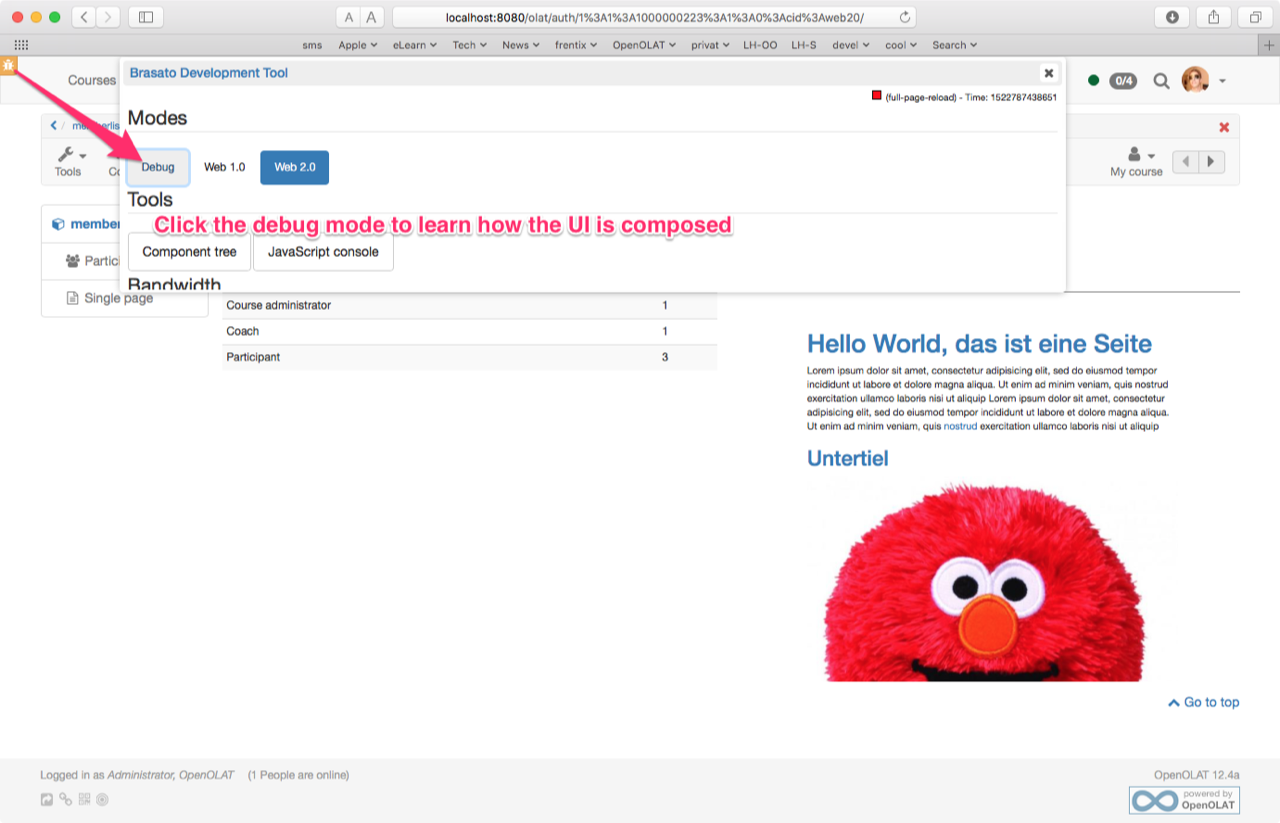OpenOLAT Entwicklung neues Menu, Codeverständnis
34 views
Skip to first unread message
carlos...@gmail.com
Mar 31, 2018, 5:46:34 AM3/31/18
to OpenOLAT
Hi,
zur Zeit studiere ich Informatik und möchte mich mit der Entwicklung von Erweiterungen für OpenOlat beschäftigen. Allerdings ist der Code gigantisch =D. Ich habe bei mir Lokal OpenOlat in Eclipse mit PostgreSQL installiert und auch durchs Lesen vom Forum den Debugger aktivieren können. Leider bekomme ich nicht so klar, wie man oder wo man eine kleine Veränderung wie zum Beispiel ein neues Menu hinzuzufügen aufbauen soll. Ich habe mir die Code-Teile unter GUI_demo angesehen aber würde leider nicht wissen, wo man sie hinzufügen kann, um Veränderungen zu konstruieren. Wenn ich neue Funktionen einer Klasse durch eine Menu-Erweiterung in einem Kurs veröffentlichen möchte, wie soll ich vorgehen? Beispiel: In der Menu-Leiste ein neues Menu "Keywords" zur Verfügung stellen, sodass jeder Benutzer die Schlüsselwörter dieses Kurses sehen kann.
Falls mein Anliegen nicht klar formuliert ist, versuche ich gerne nochmal ;)
Vielen Dank!
Viele Grüße
Carlos
Florian Gnaegi
Apr 3, 2018, 4:33:36 PM4/3/18
to open...@googlegroups.com
Hi Carlos
I answer in english as the mailing list is english, I hope this is ok ;-)
zur Zeit studiere ich Informatik und möchte mich mit der Entwicklung von Erweiterungen für OpenOlat beschäftigen. Allerdings ist der Code gigantisch =D. Ich habe bei mir Lokal OpenOlat in Eclipse mit PostgreSQL installiert und auch durchs Lesen vom Forum den Debugger aktivieren können. Leider bekomme ich nicht so klar, wie man oder wo man eine kleine Veränderung wie zum Beispiel ein neues Menu hinzuzufügen aufbauen soll. Ich habe mir die Code-Teile unter GUI_demo angesehen aber würde leider nicht wissen, wo man sie hinzufügen kann, um Veränderungen zu konstruieren. Wenn ich neue Funktionen einer Klasse durch eine Menu-Erweiterung in einem Kurs veröffentlichen möchte, wie soll ich vorgehen? Beispiel: In der Menu-Leiste ein neues Menu "Keywords" zur Verfügung stellen, sodass jeder Benutzer die Schlüsselwörter dieses Kurses sehen kann.
First: congratulations you managed installing OpenOLAT from scratch. I’m glad you have already been diving into the code - learning to code for OpenOLAT involves using the debugger and stepping through the code execution a lot.
Unfortunately I don’t understand what menu you are referring to. There are different words we use for some parts in OpenOLAT, see the attached screenshot.
BTW: make sure you have set the debug flag in your olat.local.properties:
olat.debug=true
When in debug mode, you will see an icon in the top left corner, this is the developer tool menu.
Cheers
Florian



Falls mein Anliegen nicht klar formuliert ist, versuche ich gerne nochmal ;)Vielen Dank!Viele GrüßeCarlos
--
--
Sie erhalten diese Nachricht, weil Sie Mitglied sind von Google
Groups-Gruppe "OpenOLAT".
Für das Erstellen von Beiträgen in dieser Gruppe senden Sie eine E-Mail
an open...@googlegroups.com
Um sich von dieser Gruppe abzumelden, senden Sie eine E-Mail an
openolat+u...@googlegroups.com
Weitere Optionen finden Sie in dieser Gruppe unter
http://groups.google.com/group/openolat?hl=de
-------------------------------------------------------------------------------------------------------------------
OpenOLAT - infinite learning - http://www.openolat.org
---
You received this message because you are subscribed to the Google Groups "OpenOLAT" group.
To unsubscribe from this group and stop receiving emails from it, send an email to openolat+u...@googlegroups.com.
For more options, visit https://groups.google.com/d/optout.
--------------------------------------------------------------------
professional services for the e-learning system OpenOLAT
hosting - operating - support - development - mobile - consulting
--------------------------------------------------------------------
frentix GmbH
Florian Gnägi, Geschäftsführer
Hardturmstrasse 76
CH-8005 Zürich, Switzerland
--------------------------------------------------------------------
Carlos Santos
Apr 6, 2018, 8:26:27 AM4/6/18
to OpenOLAT
Hi Florian,
yes, english is ok. Thanks for the answer.
To my menu question: there are static pages in your screenshot.
Let say I want to add a static page to those: I should add the proper Code to a new Entry unter the responsible RunController for this part. I did that already and get a failed reference to the content. Something like openolat could not found the content to the new menu entry. Where are these informations saved? I think openolat uses postgresql to get this from a table, right? I saw in the code a reference to the css file like myCourseLink.setElementCssClass("o_sel_mycourses_my"); If I want to create my own static page, should I create a database table to hold the information? Unfortunatelly I dont see any table in postgresql named "coaching", "info" or something for the static pages from the screenshot. Are the labels hard coded? I guess im missing something in this line myCoursesStackPanel.pushController(translate("search.mycourses.student"), myCoursesCtrl); where I suppose search.mycourses.student for example is the reference to the content. I couldnt find this reference under postgresql... Thanks for your time.
Greets.
Carlos
Florian Gnägi
Apr 9, 2018, 5:24:47 AM4/9/18
to open...@googlegroups.com
What do you mean by "static page"? Please be precise with the naming of things. Look at the screenshot I sent you. Are you referring to "Static sites“? The page is the whole thing.
Have a look at the sites interface. Search for SiteInstance and three you will have plenty of examples how this is done.
Cheers
Florian
Reply all
Reply to author
Forward
0 new messages
